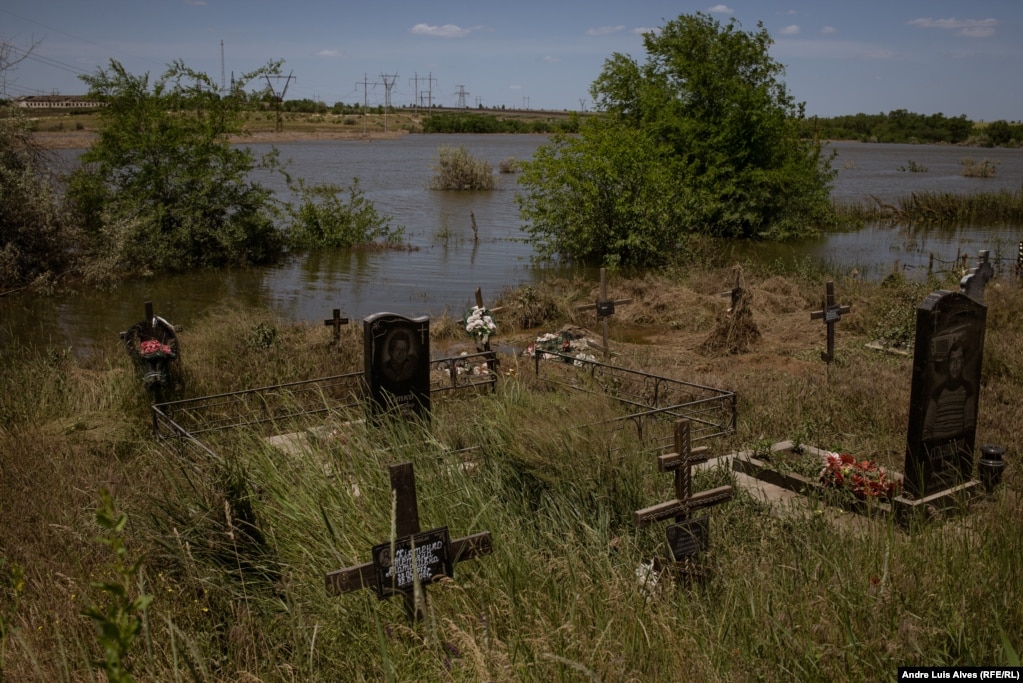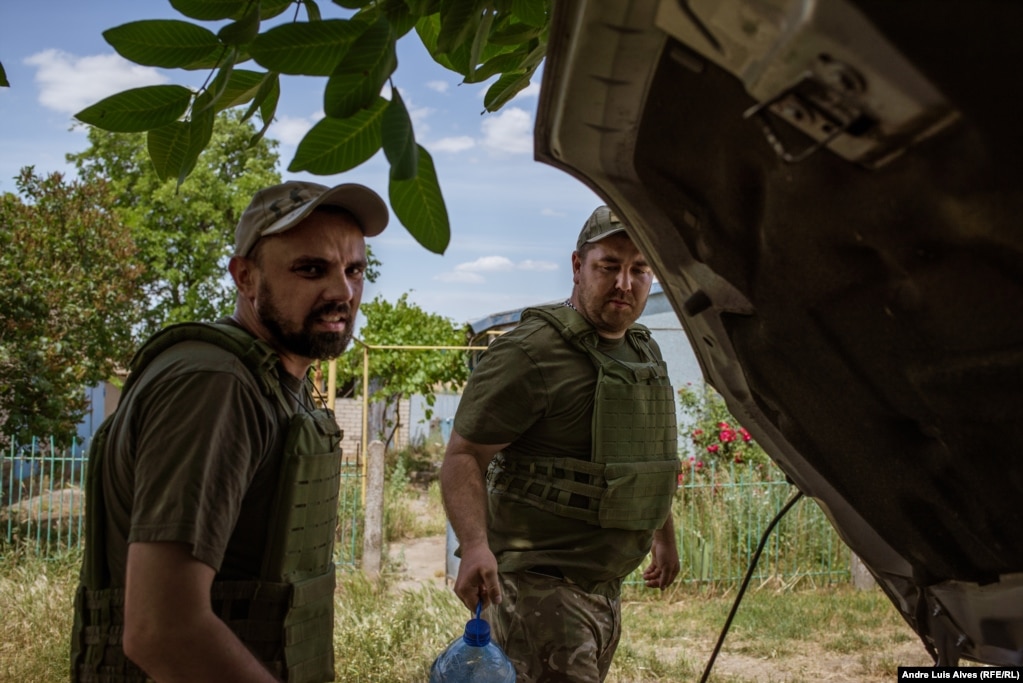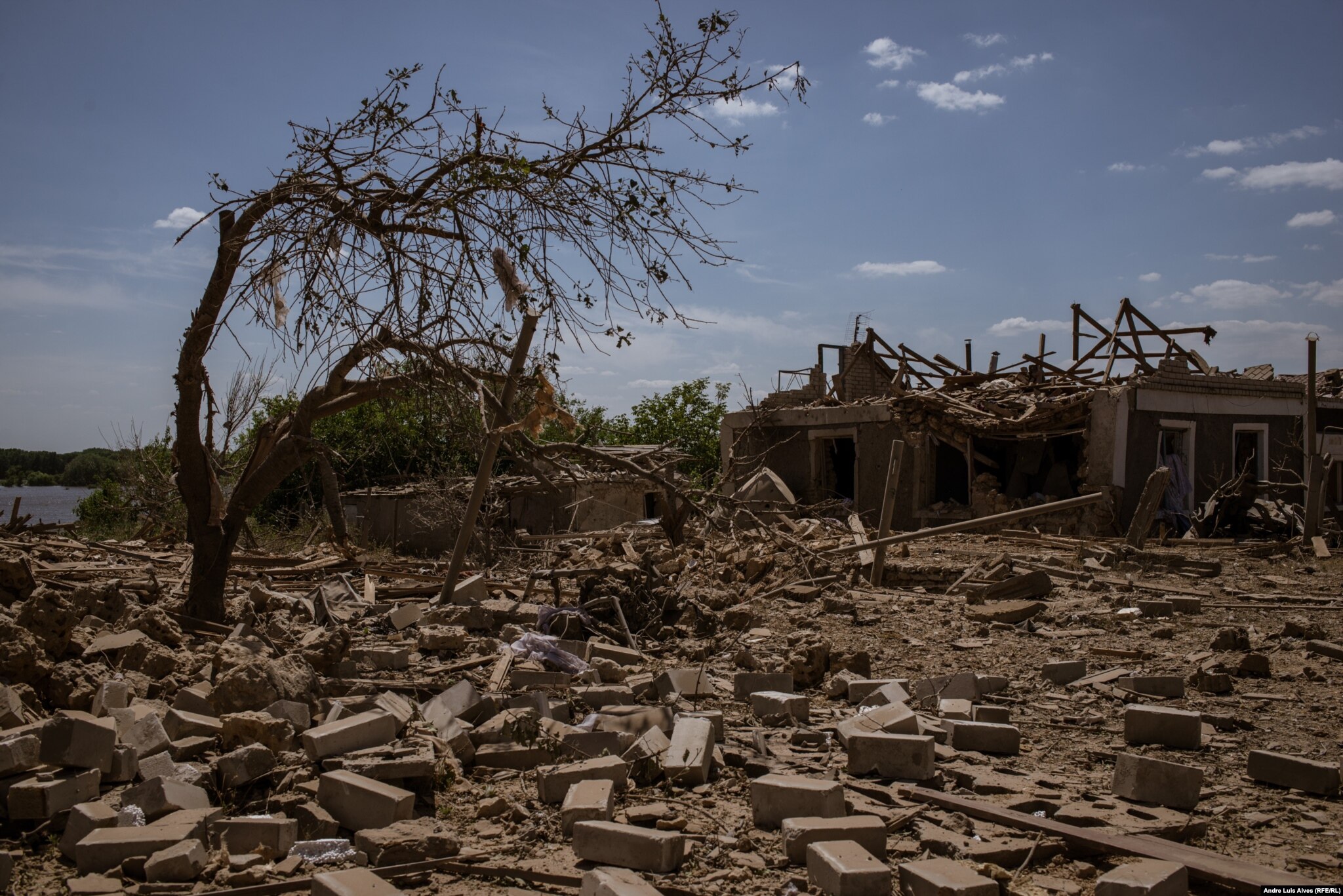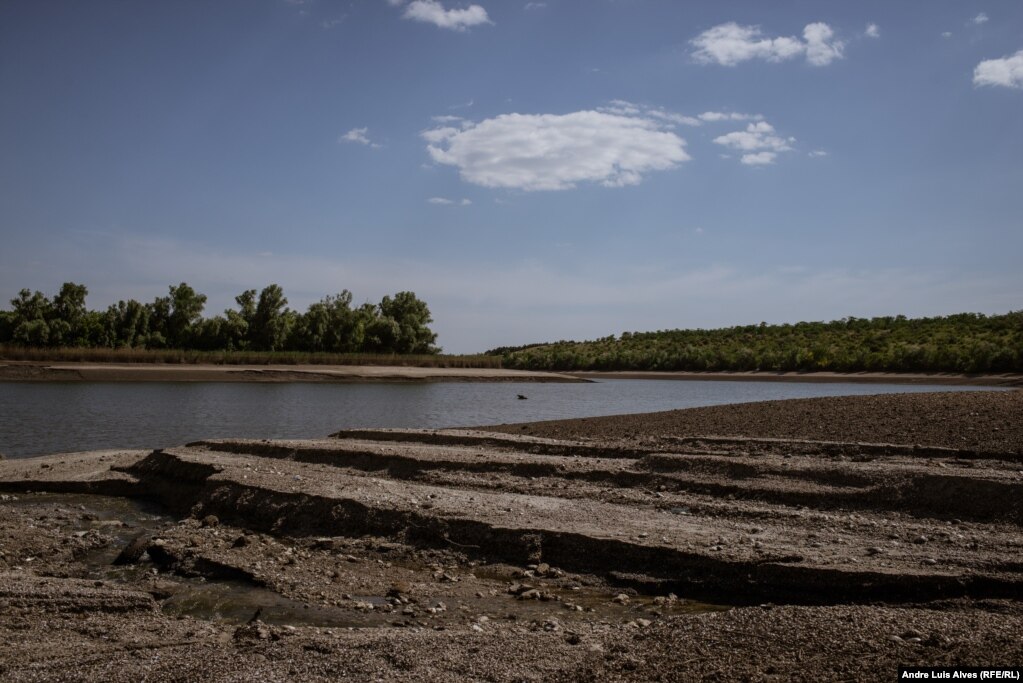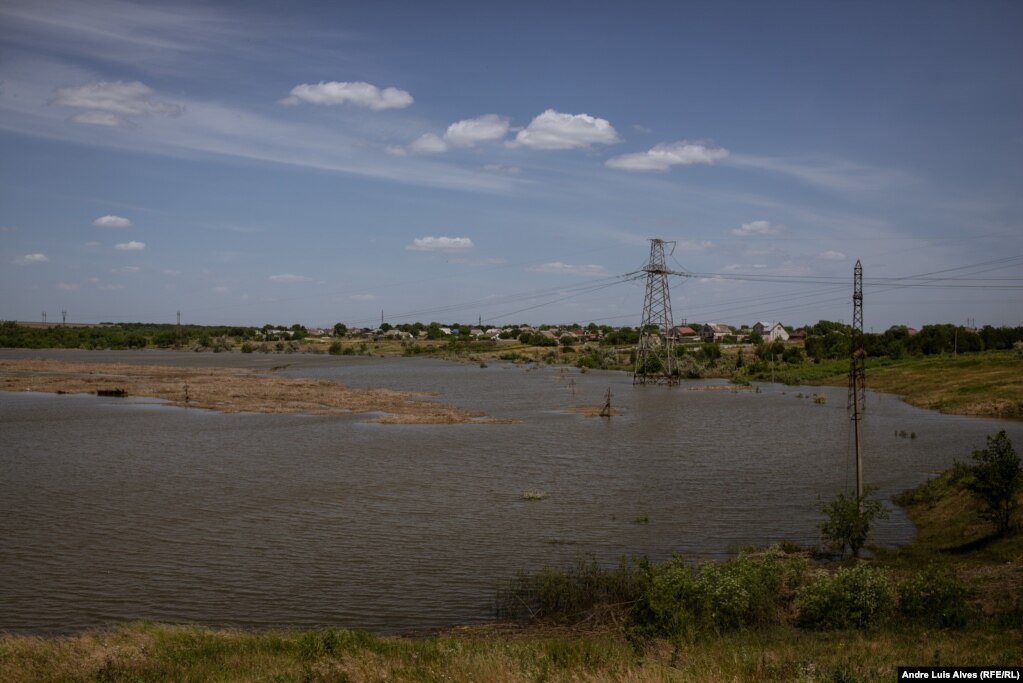Associated Press
June 11, 2023
The destruction of the Kakhovka Dam was a fast-moving disaster that is swiftly evolving into a long-term environmental catastrophe affecting drinking water, food supplies and ecosystems reaching into the Black Sea.
The short-term dangers can be seen from outer space — tens of thousands of parcels of land flooded, and more to come. Experts say the long-term consequences will be generational.
For every flooded home and farm, there are fields upon fields of newly planted grains, fruits and vegetables whose irrigation canals are drying up.
Thousands of fish were left gasping on mud flats.
Fledgling water birds lost their nests and their food sources.
Countless trees and plants were drowned.
If water is life, then the draining of the Kakhovka reservoir creates an uncertain future for the region of southern Ukraine that was an arid plain until the damming of the Dnieper River 70 years ago.
The Kakhovka Dam was the last in a system of six Soviet-era dams on the river, which flows from Belarus to the Black Sea.
Then the Dnieper became part of the front line after Russia’s invasion last year.
“All this territory formed its own particular ecosystem, with the reservoir included,” said Kateryna Filiuta, an expert in protected habitats for the Ukraine Nature Conservation Group.
The short term
Ihor Medunov is very much part of that ecosystem.
His work as a hunting and fishing guide effectively ended with the start of the war, but he stayed on his little island compound with his four dogs because it seemed safer than the alternative.
Still, for months the knowledge that Russian forces controlled the dam downstream worried him.
SEE ALSO

Ukraine claims intercepted call proves Russia blew up Nova Kakhovka dam
The six dams along the Dnieper were designed to operate in tandem, adjusting to each other as water levels rose and fell from one season to the next.
When Russian forces seized the Kakhovka Dam, the whole system fell into neglect.
Whether deliberately or simply carelessly, the Russian forces allowed water levels to fluctuate uncontrollably.
They dropped dangerously low in winter and then rose to historic peaks when snowmelt and spring rains pooled in the reservoir.
Until Monday, the waters were lapping into Medunov’s living room.
Now, with the destruction of the dam, he is watching his livelihood literally ebb away.
The waves that stood at his doorstep a week ago are now a muddy walk away.
“The water is leaving before our eyes,” he told The Associated Press. “Everything that was in my house, what we worked for all our lives, it’s all gone. First it drowned, then, when the water left, it rotted.”
Since the dam’s collapse Tuesday, the rushing waters have uprooted landmines, torn through caches of weapons and ammunition, and carried 150 tons of machine oil to the Black Sea.
Entire towns were submerged to the rooflines, and thousands of animals died in a large national park now under Russian occupation
Rainbow-colored slicks already coat the murky, placid waters around flooded Kherson, the capital of southern Ukraine’s province of the same name.
Abandoned homes reek from rot as cars, first-floor rooms and basements remain submerged.
Enormous slicks seen in aerial footage stretch across the river from the city’s port and industrial facilities, demonstrating the scale of the Dnieper’s new pollution problem.
Ukraine’s Agriculture Ministry estimated 10,000 hectares (24,000 acres) of farmland were underwater in the territory of Kherson province controlled by Ukraine, and “many times more than that” in territory occupied by Russia.
Farmers are already feeling the pain of the disappearing reservoir. Dmytro Neveselyi, mayor of the village of Maryinske, said everyone in the community of 18,000 people will be affected within days.
“Today and tomorrow, we’ll be able to provide the population with drinking water,” he said. After that, who knows. “The canal that supplied our water reservoir has also stopped flowing.”
The long term
The waters slowly began to recede on Friday, only to reveal the environmental catastrophe looming.
The reservoir, which had a capacity of 18 cubic kilometers (14.5 million acre-feet), was the last stop along hundreds of kilometers of river that passed through Ukraine’s industrial and agricultural heartlands.
For decades, its flow carried the runoff of chemicals and pesticides that settled in the mud at the bottom.

Ukrainian authorities are testing the level of toxins in the muck, which risks turning into poisonous dust with the arrival of summer, said Eugene Simonov, an environmental scientist with the Ukraine War Environmental Consequences Working Group, a non-profit organization of activists and researchers.
The extent of the long-term damage depends on the movement of the front lines in an unpredictable war.
SEE ALSO

UKRAINE WAR
Russian troops ‘swept away’ by flooding from Ukraine dam collapse
Can the dam and reservoir be restored if fighting continues there?
Should the region be allowed to become arid plain once again?
Ukrainian Deputy Foreign Minister Andrij Melnyk called the destruction of the dam “the worst environmental catastrophe in Europe since the Chernobyl disaster.”
The fish and waterfowl that had come to depend on the reservoir “will lose the majority of their spawning grounds and feeding grounds,” Simonov said.
Downstream from the dam are about 50 protected areas, including three national parks, said Simonov, who co-authored a paper in October warning of the potentially disastrous consequences, both upstream and downstream, if the Kakhovka Dam came to harm.
It will take a decade for the flora and fauna populations to return and adjust to their new reality, according to Filiuta.
And possibly longer for the millions of Ukrainians who lived there.

In Maryinske, the farming community, they are combing archives for records of old wells, which they’ll unearth, clean and analyze to see if the water is still potable.
“Because a territory without water will become a desert,” the mayor said.
26
What do you think? Post a comment.
Further afield, all of Ukraine will have to grapple with whether to restore the reservoir or think differently about the region’s future, its water supply, and a large swath of territory that is suddenly vulnerable to invasive species — just as it was vulnerable to the invasion that caused the disaster to begin with.
“The worst consequences will probably not affect us directly, not me, not you, but rather our future generations, because this man-made disaster is not transparent,” Filiuta said. “The consequences to come will be for our children or grandchildren, just as we are the ones now experiencing the consequences of the Chernobyl disaster, not our ancestors.”
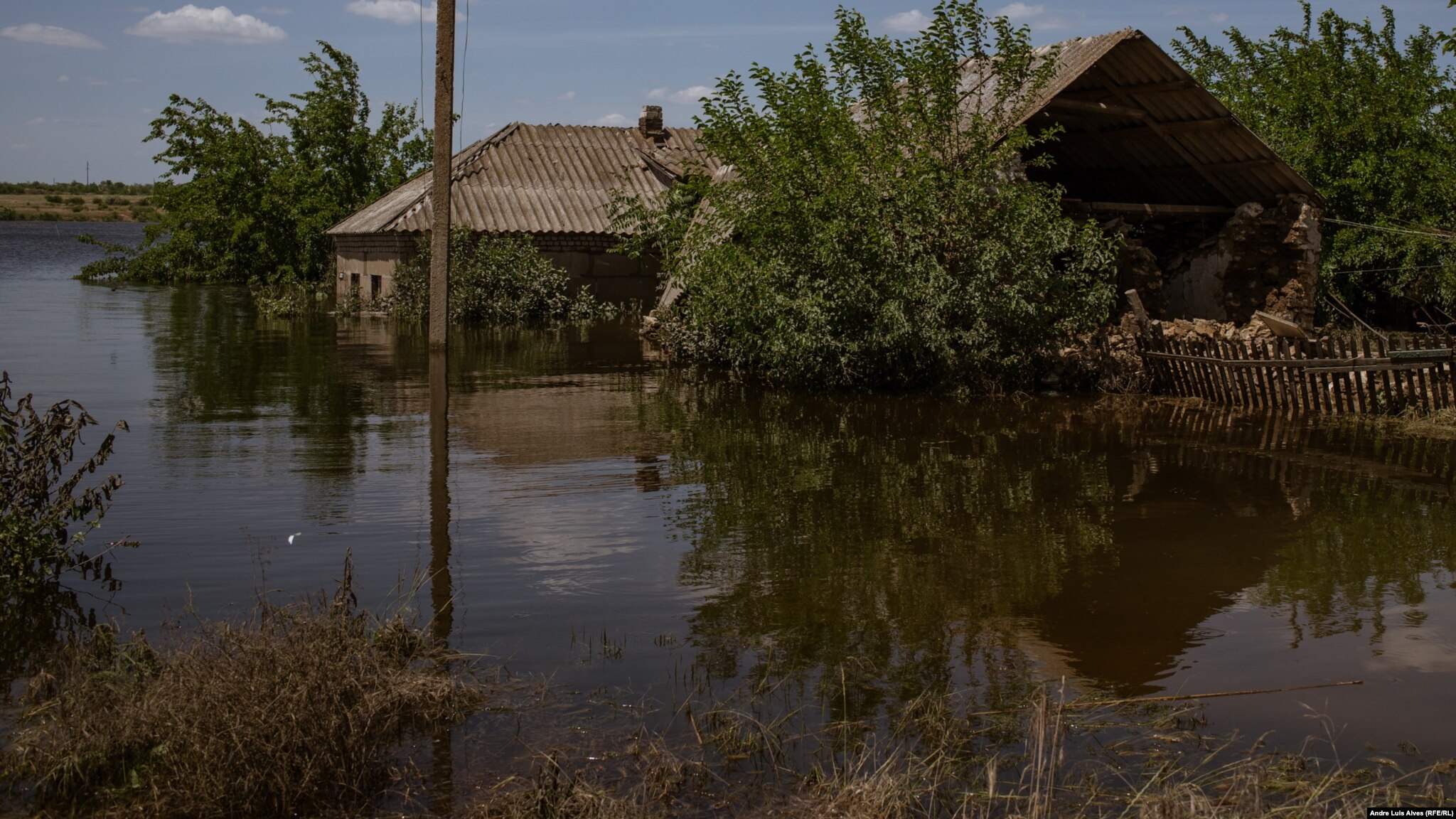
A flooded cottage in the village of Odradokamyanka that had earlier been damaged by shelling. Photo: Andre Luis Alves (RFE/RL)
ODRADOKAMYANKA, Ukraine -- The cemetery in this riverside steppe village got flooded within hours of the breach of the Nova Kakhovka dam, located five kilometers upstream on the Dnieper River. Three days later, when Mykhailo Boyarskiy, a farmer from the nearby Kozatske village who used to visit his family graves here, came to the cemetery, he saw wooden crosses and granite monuments covered with mud and rotting weed. An otter was swimming meters away, and the smell of dead fish was in the air.
The breach of the Russian-held Soviet-era hydroelectric dam in the early hours of June 6 unleashed a torrent of water that flooded villages and sparked the evacuation of tens of thousands of people from both sides of the Dnieper River in Ukraine's southern Kherson region. It also caused what many fear is one of Europe's biggest environmental disasters in decades.
Unlike some villages located at a lower altitude down the Dnieper, Odradokamyanka got flooded only to a limited extent. Three days after the dam breach, several houses remained under water, and its artificial lakes spilled deep into the surrounding fields.
"It turns out we kicked them out of here just to get this mess in return," Boyarskiy said in a characteristic mixture of Ukrainian and Russian that is widely spoken here, referring to the Russian troops driven out of the region by the Ukrainian Army last autumn.
Two of Boyarskiy’s friends who preferred not to disclose their identity -- middle-aged farmers taking care of the local animal stock -- were in the village the night the Nova Kakhovka dam was destroyed.
The men with faces tired from lack of sleep said that, after they heard a loud bang, they went to the riverbank with a thermographic camera and saw torrents of water cascading downstream. The farm livestock and wild animals from the other side were trying to swim to the higher right bank of the Dnieper, they said, but the rushing current and whirlpools drowned them.
Russian Soldiers 'Washed Away'
They also said a Russian reconnaissance group that was approaching the Ukrainian-controlled territory with a boat -- a typical occurrence on this part of the Dnieper, which has effectively turned into a front line -- was caught by surprise by the flood and sought rescue on one of the river's multiple islands. "But ultimately, the water washed Russian soldiers away from the treetops," one of the men said.
Boyarskiy came to Odradokamyanka with his comrade Eduard Laktyonov to bring humanitarian aid to some of the 300 remaining in a village that had more than 3,300 residents before Russia's full-scale invasion of Ukraine. Most of those who stayed cannot move out because of old age and poor health.
The mutual exchange of fire across the Dnieper did not stop despite evacuations and rescue missions continuing in the Kherson region. Plumes of smoke hover above the steppes amid the sounds of outgoing and incoming artillery rounds.
"The locals struggle to get by with shells and missiles coming every day and night," said Kostyantyn Kyrychenko, 41, one of the few younger people remaining in the village, which has electricity only from a gasoline power generator and a very limited amount of drinkable water pumped from a local well.
His wife and daughters left for the Czech Republic, while both his son and his brother are serving in the Ukrainian Army. He stays in the village to help older people. His house got partly destroyed by the shells that fell close to it, and he only has a dugout cellar to hide in.
"The only thing I need is for you to bring me new pair of glasses finally," he told Boyarskiy, who handed over a box with food and other products as Kyrychenko gave him a freshly caught fish in exchange.
According to several residents, the Russian Army is shelling Odradokamyanka with mortars, artillery rounds, and missiles, and attacking it with planes daily. Numerous private houses, the school, the village council, other buildings, and an unknown soldier's monument, have all been razed to the ground.
The civilian population of the Kherson region, which first survived the brutal Russian occupation and later lived alongside daily shelling and air attacks, is now bound to face what Ukrainian President Volodymyr Zelenskiy described as "an environmental bomb of mass destruction."
Entire Ecosystems 'At Risk'
This threat is felt acutely in the nearby Kamyanska Sich National Nature Park, a nature reserve named after a historical fortified Cossack settlement that was located in the area, which sits on the bank of the Kakhovka Reservoir.
Ukraine's environment minister, Ruslan Strilets, said that, in some places, the water in the reservoir had moved almost 160 meters away from the shore. Its banks will turn into salt marshes and will not be suitable for the existence of any living things for decades, he said. Ukrainian officials estimate that about 28,000 fish have already died due to the draining.
The director of the Kamyanska Sich park, Serhiy Skoryk, who spent the last months demining the site after the Russian occupation, is now occupied with controlling the water level and easing the collateral damage caused by the flooding.
Three days after the dam's breach, he and his team were removing boxes with explosive materials left by Russians and uncovered under a destroyed bridge after the water level dropped. Dried mussel shells were cracking under the boots of his team pulling the green box with TNT.
The Kamyanska Sich National Nature Park is one of 60 protected areas that suffered because of the breach of the Nova Kakhovka dam, Ivan Moysiyenko, chief of the Botany Department at Kherson State University and a member of Ukrainian Nature Conservation Group, told RFE/RL.
The flooding of areas in the lower Dnieper below the destroyed Nova Kakhovka dam and the drying of the areas above it, as well as the contamination of the Black Sea, will put entire ecosystems of flora and fauna at risk of irreversible loss, he said.
According to Moysiyenko, more than 19 endangered species listed in the Red Data Book and dozens of species protected by the Berne Convention will disappear from these places forever. Hundreds of species and hundreds of thousands of animals and plants will be affected, and in the case of some endemic species, as much as 20 percent of the world population could be extinct, he said.
The environmental disaster will affect territories that have never been under water, such as the Oleshky Sands National Nature Park, Europe's biggest desert, and destabilize places such as the UNESCO-protected Black Sea Biosphere Reserve.
"This is an international ecological catastrophe, and as long as the fighting goes on, not much can be done for the environment," Moysiyenko said.





